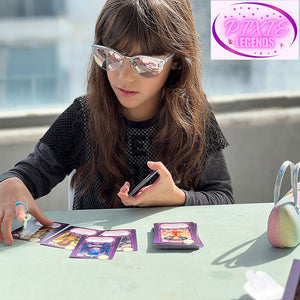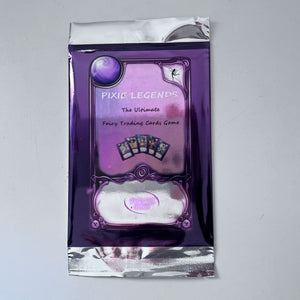Japan has a rich cultural history, and the country is known for its folklore and mythology. Japanese mythology is filled with a wide variety of supernatural creatures, including many different types of fairies. In this article, we'll take a closer look at some of the top Japanese fairies, their main features, how they look, and their secret powers or talents.
Yōsei Japanesse fairy
Yōsei, also known as Yosei or Tinkerbell, is a well-known fairy in Japanese folklore. These fairies are depicted as small, winged creatures that possess magical powers and are often associated with nature.
Yōsei are believed to have the ability to manipulate the natural world and can communicate with animals and plants. They are known to be kind and gentle, and their main goal is to protect and preserve the environment.
These fairies are often depicted wearing green or brown clothes, with delicate wings that resemble those of a butterfly. Their eyes are large and expressive, and they often carry small items such as wands or flowers.
One of Yōsei's secret powers is the ability to bring good luck and prosperity to those who show kindness and respect for nature. They are also known to have healing powers, and are said to be able to cure ailments and injuries.
One famous story about Yōsei is the tale of Momotaro, a boy who was born from a peach. In this story, Yōsei helped Momotaro on his journey to defeat demons and save his village. Yōsei also appears in various manga and anime, including the popular series "Fairy Tail".
Overall, Yōsei is a beloved and respected fairy in Japanese folklore, embodying the importance of nature and the power of kindness.
Kappa Japanesse Fairy
Kappa is one of the most well-known fairies in Japanese mythology. They are often depicted as small, green humanoid creatures with webbed feet and a shell on their back. Kappa are known for their love of water and are often found near rivers or ponds. They are mischievous creatures that enjoy playing tricks on humans. However, they are also said to have a secret power of healing. Kappa are said to have a special liquid in their head that can heal wounds and diseases.
Kitsune Japanesse Fairy
Kitsune is a type of fairy that is often depicted as a fox. They are known for their intelligence, and they are said to have the ability to shape-shift into human form. Kitsune are often depicted with multiple tails, with the number of tails representing their age and wisdom. They are mischievous creatures that enjoy playing tricks on humans. However, they are also said to have secret powers of illusion and possession. Kitsune are said to be able to create illusions that can trick humans, and they are also said to be able to possess humans and control their actions.
Tengu Japanesse Fairy
Tengu is a type of fairy that is often depicted as a bird-like creature with a long nose. They are known for their fierce demeanor and are often associated with martial arts. Tengu are said to be able to control the wind and are often depicted with large wings that allow them to fly. They are also said to have secret powers of invisibility and transformation. Tengu are said to be able to turn invisible and blend into their surroundings, and they are also said to be able to transform into other creatures or objects.
Oni Japanesse Fairy
Oni is a type of fairy that is often depicted as a large, muscular humanoid creature with horns and a wild expression. They are known for their strength and ferocity, and they are often depicted with large clubs or axes. Oni are said to be able to control fire and are often associated with volcanic activity. They are also said to have secret powers of possession and shape-shifting. Oni are said to be able to possess humans and control their actions, and they are also said to be able to shape-shift into other creatures or objects.
Yuki Onna Japanesse Fairy
Yuki Onna is a type of fairy that is often depicted as a beautiful woman with long black hair and pale skin. She is often associated with winter and snow, and she is said to be able to control the weather. Yuki Onna is a gentle fairy that is often depicted helping lost travelers in the snow. However, she is also said to have a secret power of death. Yuki Onna is said to be able to freeze humans to death with a touch of her icy breath.
Nekomata Japanesse Fairy
Nekomata is a type of fairy that is often depicted as a cat with two tails. They are known for their mischievous and playful nature, and they are often associated with good luck. Nekomata are said to have secret powers of transformation and possession. They are said to be able to transform into other creatures or objects, and they are also said to be able to possess humans and control their actions.
Kijimuna Japanesse Fairy
Kijimuna is a type of fairy that is unique to Okinawa. They are often depicted as small, child-like creatures with green skin and red hair.
Kijimuna are known for their mischievous nature, and they are said to enjoy playing pranks on humans. They are also said to have a secret power of strength. Kijimuna are said to possess incredible physical strength, which they use to move heavy objects or perform feats of agility.

Jorogumo Japanesse Fairy
Jorogumo is a type of fairy that is often depicted as a spider with a woman's face. They are known for their seductive nature, and they are said to use their beauty to lure unsuspecting men into their webs. Jorogumo are said to have secret powers of illusion and transformation. They are said to be able to create illusions that can trick humans, and they are also said to be able to transform into other creatures or objects.
Tanuki Japanesse Fairy
Tanuki is a type of fairy that is often depicted as a raccoon dog. They are known for their playful nature and their love of alcohol. Tanuki are often depicted with large, rounded bellies and a straw hat. They are said to have secret powers of transformation and illusion. Tanuki are said to be able to transform into other creatures or objects, and they are also said to be able to create illusions that can trick humans.
Kasa-obake Japanesse Fairy
Kasa-obake is a type of fairy that is often depicted as a one-eyed umbrella. They are known for their mischievous nature, and they are said to enjoy playing pranks on humans. Kasa-obake are said to have secret powers of transformation and levitation. They are said to be able to transform into other objects, such as brooms or lanterns, and they are also said to be able to levitate and fly.
In conclusion, Japanese fairies come in many different forms and possess a wide variety of secret powers and talents. From the mischievous Kappa and Kitsune to the fierce Oni and Tengu, each fairy has its own unique features and characteristics. Whether they are helping lost travelers in the snow or playing tricks on unsuspecting humans, Japanese fairies are a fascinating and integral part of Japanese mythology and culture.











